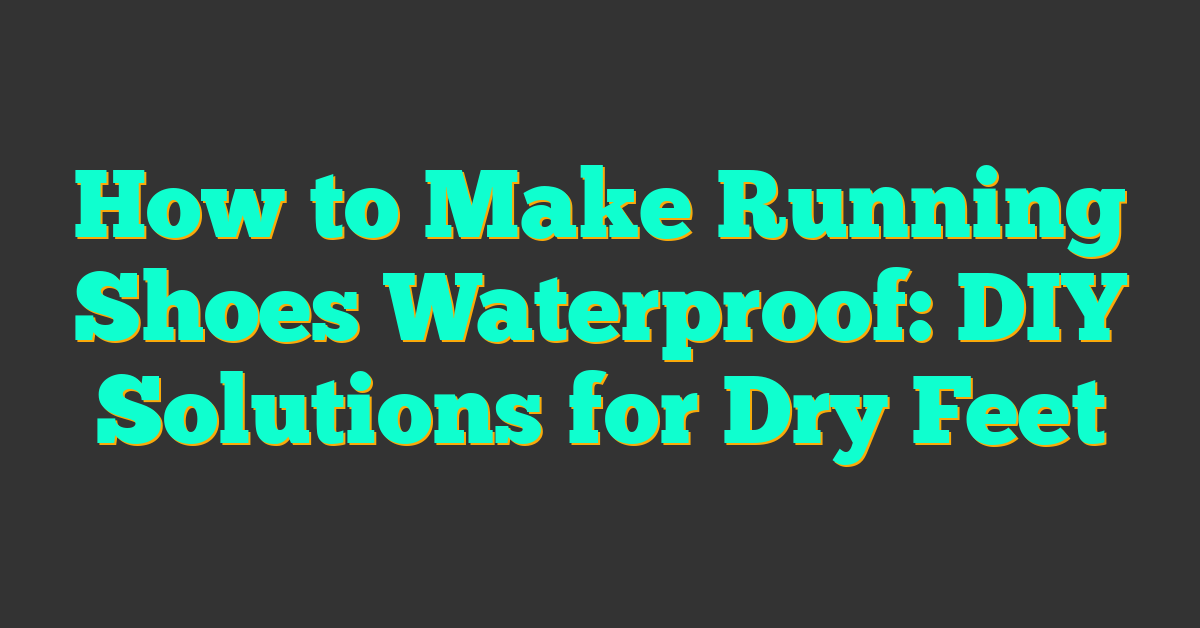If you’re a runner, you know that there’s nothing worse than getting caught in the rain with shoes that aren’t waterproof. Wet feet can be uncomfortable and even dangerous, especially in colder weather. Luckily, there are several DIY solutions that can help you make your running shoes waterproof. In this article, we’ll cover everything you need to know about how to make running shoes waterproof, from understanding waterproofing to caring for your shoes after they’ve been waterproofed.

Understanding waterproofing is the first step in making your running shoes waterproof. There are several different methods you can use to waterproof your shoes, and each one has its own advantages and disadvantages. Some methods are more effective than others, and some are easier to apply than others. By understanding the different methods of waterproofing, you can choose the one that’s best for your needs.
Preparation and cleaning are also important steps in making your running shoes waterproof. Before you start applying any waterproofing solution, you’ll need to make sure your shoes are clean and dry. This will help the waterproofing solution adhere to the shoes more effectively, ensuring a better result. In addition, some waterproofing solutions require specific preparation steps, such as heating the shoes or applying a base coat. By following the preparation and cleaning steps carefully, you can ensure that your shoes are properly waterproofed.
Key Takeaways
- Understanding the different methods of waterproofing is important before choosing a solution.
- Proper preparation and cleaning of shoes is necessary before applying any waterproofing solution.
- Caring for your waterproofed shoes is important to ensure they last longer.
Understanding Waterproofing
https://www.youtube.com/watch?v=y83uXupu5tY&embed=true

When it comes to running shoes, having waterproofing can be a game-changer. It can make your runs more comfortable and keep your feet dry in wet conditions. But what exactly is waterproofing, and how does it work? In this section, we’ll explain the basics of waterproofing and what you need to know to make your running shoes waterproof.
Waterproof vs Water-Resistant
One of the first things to understand is the difference between waterproof and water-resistant. Water-resistant shoes are designed to repel water to some extent, but they are not completely waterproof. This means that they can withstand some exposure to water, but if they are submerged or exposed to heavy rainfall for an extended period, water can still seep in. On the other hand, waterproof shoes are designed to keep your feet completely dry, even in heavy rain or when submerged in water.
Benefits of Waterproof Running Shoes
Having waterproof running shoes can provide several benefits. First and foremost, they keep your feet dry, which can help prevent blisters and other foot-related issues. Additionally, they can make running in wet conditions more comfortable, as you won’t have to worry about wet socks or squishy shoes. Waterproof shoes can also be easier to clean, as you can simply wipe them down with a damp cloth.
It’s important to note that not all waterproof shoes are created equal. Some shoes may be labeled as “water-resistant” or “waterproof,” but they may not be 100% waterproof. Additionally, some shoes may be more breathable than others, which can affect their ability to keep your feet dry. When choosing waterproof running shoes, it’s essential to consider your needs and the conditions you’ll be running in to ensure that you get the right shoes for your needs.
Preparation and Cleaning
https://www.youtube.com/watch?v=d7ULpf00sjk&embed=true
Before you start waterproofing your running shoes, it’s important to prepare them properly. This will ensure that the waterproofing solution adheres to the shoes and provides the best protection possible. In this section, we will discuss how to clean and dry your running shoes before applying any waterproofing solution.
Cleaning Your Running Shoes
The first step in preparing your running shoes for waterproofing is to clean them thoroughly. Use a soft-bristled brush or a damp cloth to remove any dirt or debris from the surface of the shoes. Pay special attention to the areas where the sole meets the upper, as these areas tend to collect a lot of dirt and debris.
If your shoes are particularly dirty, you can use a bit of laundry detergent to help remove stubborn stains. Mix a small amount of detergent with warm water and use a soft-bristled brush to gently scrub the shoes. Be sure to rinse the shoes thoroughly with clean water to remove any soap residue.
Drying Techniques
After cleaning your running shoes, it’s important to dry them properly before applying any waterproofing solution. There are a few different methods you can use to dry your shoes, depending on your preference and the materials your shoes are made from.
One option is to stuff your shoes with newspaper or paper towels. This will help absorb any excess moisture and speed up the drying process. Alternatively, you can place your shoes in a well-ventilated area and allow them to air dry naturally.
If you’re in a hurry, you can use a hairdryer on a low heat setting to dry your shoes more quickly. Be sure to hold the dryer a few inches away from the shoes and move it around constantly to avoid overheating any one area.
Remember, it’s important to let your shoes dry completely before applying any waterproofing solution. This will ensure that the solution adheres properly and provides the best protection possible.
Waterproofing Methods
https://www.youtube.com/watch?v=B7rdKM-0fp4&embed=true
When it comes to waterproofing your running shoes, there are a variety of methods you can use to keep your feet dry. Here are three popular methods you can try at home:
Wax-Based Solutions
Wax-based solutions are a popular choice for waterproofing shoes. Beeswax is a common ingredient in many wax-based waterproofing solutions because it is natural, eco-friendly, and effective. To use a wax-based solution, you’ll need to follow these steps:
- Clean your shoes with a damp cloth and let them dry completely.
- Apply the wax-based solution to your shoes using a clean cloth or brush.
- Use a hair dryer or heat gun to melt the wax into the shoe’s fabric.
- Let the shoes cool and dry completely before wearing them.
Waterproofing Sprays
Waterproofing sprays are another popular choice for waterproofing your running shoes. Silicone or acrylic polymers are often used in waterproofing sprays because they create a barrier that repels water. To use a waterproofing spray, you’ll need to follow these steps:
- Clean your shoes with a damp cloth and let them dry completely.
- Apply the waterproofing spray to your shoes in a well-ventilated area.
- Let the shoes dry completely before wearing them.
DIY Waterproofing Mixtures
If you prefer a more natural approach to waterproofing your shoes, you can try making your own waterproofing mixture using household items. Here are a few DIY waterproofing mixtures you can try:
- Vaseline and beeswax: Melt equal parts of vaseline and beeswax in a double boiler, then apply the mixture to your shoes using a clean cloth or brush.
- Mink oil and beeswax: Melt equal parts of mink oil and beeswax in a double boiler, then apply the mixture to your shoes using a clean cloth or brush.
- Sprays and waxes: Mix equal parts of waterproofing spray and beeswax in a spray bottle, then apply the mixture to your shoes.
Whichever method you choose, make sure to test it on a small, inconspicuous area of your shoe before applying it to the entire shoe. This will help you avoid any unwanted discoloration or damage to your shoes.
Caring for Waterproofed Shoes
« Protect Your Ears: How to Keep Them Warm While Cycling and Why It’s Crucially Important
How to Mentally Prepare for a Triathlon: Tips and Strategies »

Once you have waterproofed your running shoes using one of the DIY solutions, it is important to take care of them to ensure they last as long as possible. Here are some tips to help you maintain your waterproofed shoes:
Maintaining Breathability
While waterproofing your shoes is important, it is equally important to maintain their breathability. This is especially true if you run in warm weather or if you have naturally sweaty feet. To maintain breathability, make sure to clean your shoes regularly. Use a soft-bristled brush to remove dirt and debris from the surface of your shoes. For leather shoes, use a leather cleaner and conditioner to keep them supple and prevent cracking.
Regular Maintenance
In addition to regular cleaning, there are other measures you can take to maintain your waterproofed shoes. For example, avoid exposing them to extreme heat, which can damage the waterproofing material. If your shoes get wet, remove the insoles and stuff them with newspaper to absorb the moisture. Avoid using a hairdryer or heater to dry them as this can cause the material to crack or shrink.
Here are some additional tips for maintaining specific types of shoes:
- Leather shoes: Apply a leather conditioner regularly to keep them soft and supple. Avoid exposing them to direct sunlight or heat as this can cause the leather to crack or fade.
- Suede shoes: Use a suede brush to remove dirt and stains. Avoid getting them wet as this can cause the material to discolor or shrink.
- Canvas and hemp shoes: Clean them with a mild detergent and warm water. Avoid using bleach or harsh chemicals as this can damage the material.
- Nubuck shoes: Use a nubuck cleaning brush to remove dirt and stains. Apply a nubuck protector spray to keep them looking new.
By following these tips, you can maintain the waterproofing of your shoes and ensure they last as long as possible. Remember to clean them regularly and avoid exposing them to extreme heat or moisture.
Considerations for Different Materials

When it comes to making your running shoes waterproof, different materials require different types of care. Here are some tips for protecting your shoes based on the material they’re made of.
Leather and Suede Care
Leather and suede are two popular materials used in running shoes. However, they require different types of care to stay in good condition. Leather shoes can be treated with colored wax to help repel water, while suede shoes should be brushed regularly to remove dirt and prevent mold and mildew from forming.
If your leather or suede shoes get wet, stuff them with newspaper and let them dry naturally. Avoid using a heat source like a hair dryer, as this can cause the material to shrink or crack.
Fabric and Canvas Protection
Fabric and canvas shoes are lightweight and breathable, but they can also be more susceptible to stains and water damage. To protect your shoes, apply a water repellent spray before wearing them in wet conditions. This will create a barrier that helps keep water out.
If your fabric or canvas shoes get stained, use a mild detergent and water to gently clean the affected area. Avoid using harsh chemicals or bleach, as this can damage the material.
By following these tips, you can help keep your running shoes looking and feeling their best, no matter what conditions you’re running in.
Frequently Asked Questions

What’s the best DIY method to waterproof my running shoes?
The best DIY method to waterproof your running shoes depends on the type of shoe you have. For fabric shoes, a homemade solution of equal parts beeswax and petroleum jelly can work well. For leather shoes, you can use a waterproofing spray or wax. Both methods are effective, but it’s important to follow the instructions carefully to ensure the best results.
Can I use a homemade solution to waterproof fabric shoes?
Yes, you can use a homemade solution to waterproof fabric shoes. A mixture of equal parts beeswax and petroleum jelly can work well. You can apply the mixture to the shoes using a clean cloth or brush. Make sure to cover the entire surface of the shoe, including the seams and any other areas where water can seep in.
Is it possible to waterproof my Nike sneakers at home?
Yes, it is possible to waterproof your Nike sneakers at home. You can use a waterproofing spray or wax to protect the shoes from water damage. Just make sure to choose a product that is compatible with the material of your shoes. For example, don’t use a product for leather on your textile sneakers.
How can I use wax to make my shoes water-resistant?
To use wax to make your shoes water-resistant, you will need to melt the wax and apply it to the shoes. You can use a double boiler to melt the wax or a heat gun if you don’t have one. Once the wax is melted, apply it to the shoes using a clean cloth or brush. Make sure to cover the entire surface of the shoe, including the seams and any other areas where water can seep in.
Are there any alternatives to sprays for waterproofing canvas shoes?
Yes, there are alternatives to sprays for waterproofing canvas shoes. One option is to use a wax-based product, such as Otter Wax. Another option is to use a silicone-based product, such as Nikwax Fabric and Leather Proof. Both of these products are effective at waterproofing canvas shoes.
Can WD40 be used to waterproof shoes, and how effective is it?
WD40 can be used to waterproof shoes, but it is not the most effective method. While it can repel water to some extent, it is not a long-term solution and can damage the material of your shoes over time. It is better to use a product that is specifically designed for waterproofing shoes, such as a waterproofing spray or wax.










